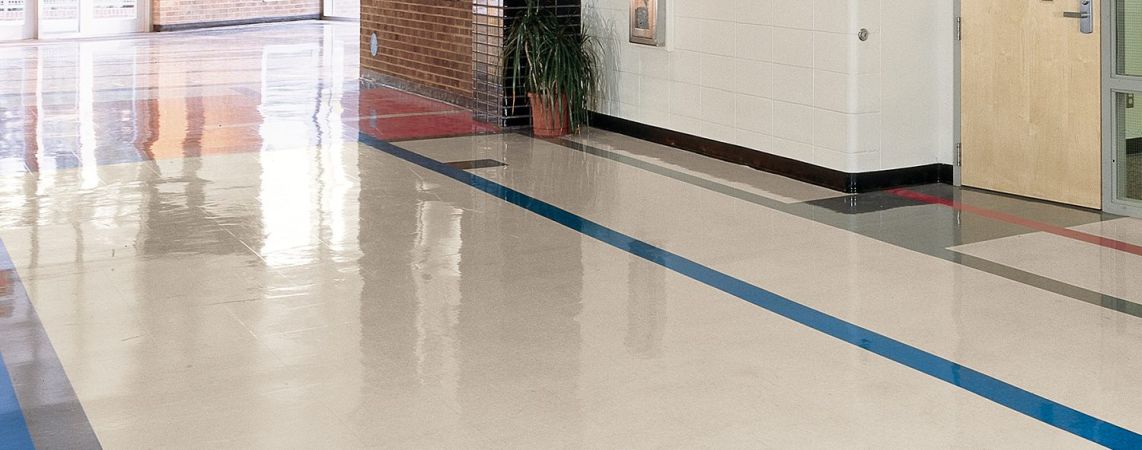School Flooring

Schools, which are educational buildings, are designed to meet the physical conditions and user needs at the best level that will contribute positively to increase the quality of education and are implemented accordingly. Classrooms, corridors, recess spaces and the laboratory are the most important places in education buildings.
CLASSROOM FLOORING
Adequate sound insulation and good audibility should be provided for classrooms and training rooms. It is necessary to avoid sources of noise and to insulate sound carrier elements. The floor coverings to be selected must comply with these features and must be capable of contributing to be better. Again, the floor coverings should be walkable, easy to clean, warm and without joints. These spaces generally have wooden flooring. It is recommended to use oily character wood such as "teak wood" or "jarrah" other than brush cleaning. These wood materials are self-oiled and do not dust easily like other solid woods.
Flexible floor covering materials such as PVC are preferred in classrooms because of its easy cleaning, walking safety, good sound absorption and at the same time it is a material that does not generate noise. Especially cork-filled PVCs are better at sound absorption, contact temperature and impact sound. Likewise, linoleum is easy to clean, although its sound absorption is moderate due to its flexible structure. It also shows good features in terms of walking safety. Since linoleum is a hot contact material, it is also suitable for foot temperature.
Carpets are very good in terms of walking safety, sound absorption and contact temperature. At the same time, it contributes to the creation of a quiet environment in classrooms as it is a material that does not generate noise. However, their cleaning and maintenance is difficult. For this reason, it can be used in classrooms that are not too crowded.
Natural and artificial stones floor coverings are easy to clean. Their abrasion resistance and walking safety are generally good and very good. However, because these materials are hard, they are not good in terms of cold contact, noise generating and sound absorption. It is not very suitable for use in classrooms.
CORRIDOR FLOORING
The floor coverings of corridors and recreation areas should be non-slip and durable. Schools are places where human traffic is intense. Therefore, the abrasion resistance of the material to be used in these places should be high.
Especially in corridors, composite block flooring is used. This material is hard wearing and dust-proof; but it is noisier than a wooden floor covering. Ordinary composite block flooring can be used in classrooms with less density than secondary schools or in smaller schools. In the latter case, very bad wear can occur if proper maintenance is not done. Colored asphalt is being used more and more by the day and seems to give very good results for corridors. In many schools, mosaic is preferred because it is easy to clean, but this material is generally quite noisy.
PVA plastic flooring is also suitable, and this material provides a wear-free surface at a reasonable price. The trend in modern schools is to offer brighter colors and hence vinyl asbestos tiles are used. This material is quiet enough, warm and does not require special care.
LABORATORIES FLOORING
The floor coverings in the laboratory are not affected by chemicals, have high joint-free abrasion resistance, waterproof, colorfast, good thermal insulation, cleaning and maintenance properties, low electricity conductivity, and require a floor covering that does not facilitate electrical charges. The best material is the material made of artificial resin and bonded to each other without joints (Epoxy).
"Teak wood" or "jarrah" floor covering works very well for these spaces. These can be burned or stained with certain acids; but this does not affect their stamina. Especially teak wood is mostly used in laboratories because of its resistance to fire and acids. "Pyinkado" is acid resistant and suitable for chemical laboratories. Linoleum is sufficiently acid resistant for general laboratory work; and if used in the desired thickness, it is quite robust. Of course, it must be placed with the appropriate adhesive. Although not completely acid-resistant, there is an increasing demand for vinyl asbestos tile floor coverings for laboratory flooring. This material will be able to withstand the weakest acids and alkalis and will give good results if any spills are wiped away in a short time.
SCHOOL FLOORING PRICES
School flooring prices vary according to the properties of the material to be used and the place to be applied.